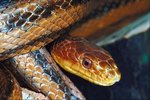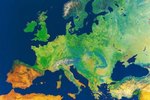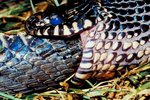
Every continent except Antarctica has temperate rainforests. Like their tropical counterparts, these areas record a high annual rainfall -- Washington's Olympic Peninsula sees an average of 12 to 14 feet yearly -- but temperatures usually remain below 80 degrees Fahrenheit. The coastal rainforests that stretch from northern California to Alaska are home to several types of slugs.
Banana Slugs
Banana slugs live in temperate rainforests from northern California to Alaska. They aid decomposition on forest floors by dining on dead plants, fungi, leaves, mushrooms and even animal droppings. During especially dry weather, they estivate by retreating beneath moist debris and sealing themselves inside a mucus shell. They also can hibernate in very cold seasons. The world’s second largest slug species, they can grow up to 10 inches long. While they’re most commonly yellow, banana slugs also can be brown, green or white.
Burrington Jumping Slug
The Burrington or keeled jumping slug occupies a small range from northwestern Oregon through western Washington, with most populations in Olympic National Park’s temperate rainforest. These slugs prefer damp forest floors with plenty of logs, stumps and fallen trees, but they avoid drenched or flooded areas. They’ve also been found in habitats with sword ferns, moss and even scree. Keeled jumping slugs are a half-inch to an inch long, gray or yellow with a black head and tentacles. Like other jumping slugs, they escape predators such as beetles, birds, snails and rodents by scrunching their bodies and then springing away.
Dromedary Jumping Slugs
Dromedary jumping slugs live in temperate rainforests on Washington’s Olympic Peninsula, the Cascade Mountain Range and Vancouver Island in Canada. They prefer areas with rotting logs, branches and other debris where they can shelter and lay their eggs. They grow to around 2 1/2 inches and usually are gray with orange or yellow undersides. Scientists have found dromedary slugs in only a few areas, and in Canada they’re listed as threatened.
Warty Jumping Slugs
Warty jumping slugs live along rivers and in temperate rainforests from Oregon to Vancouver Island. They measure less than an inch long and usually are white or gray. These slugs seek out areas with decaying leaves, logs and other organic debris, and they also seem to like sword ferns. With their populations apparently isolated and scattered, warty jumping frogs have been declared a species of special concern in Canada.
References
- Hinterland Who’s Who: Canada’s Coastal Rainforest
- National Park Service: Olympic National Park: Temperate Rain Forests
- University of Michigan Museum of Zoology: Animal Diversity Web: Ariolimax Columbianus
- Portland State University College of Urban and Public Affairs: Population Research Center: Hemphillia Burringtoni: Oregon Status Factors (PDF)
- U.S. Department of the Interior: Bureau of Land Management: Oregon: Survey and Manage: Field Guide to Survey and Manage Terrestrial Mollusk Species from the Northwest Forest Plan (PDF)
- Government of Canada: Species at Risk Public Registry: Species Profile: Dromedary Jumping-Slug
- Government of Canada: Species at Risk Public Registry: Species Profile: Warty Jumping-Slug
Resources
Photo Credits
-
Jupiterimages/Photos.com/Getty Images




